How Ancient Spices Unite Chinese and Native American Cuisines
Ever wonder why both Chinese cooks and Native American healers prized the same humble root for thousands of years? It’s not coincidence—it’s ginger, the ancient spice that mysteriously connects these distant cultures across oceans and centuries.
I’m about to take you on a flavor journey showing how ancient spices unite Chinese and Native American cuisines in ways that will transform your understanding of food history.
The similarities are uncanny. While Chinese medicine prescribed ginger tea for nausea 5,000 years ago, Cherokee healers independently discovered the same properties. Both cultures even used similar preparation methods without any documented contact.
But here’s where it gets interesting: these parallel discoveries didn’t just happen with one spice. The pattern repeats across dozens of ingredients that formed the backbone of two of history’s most sophisticated food systems.
The Common Spice Heritage: Unexpected Global Connections
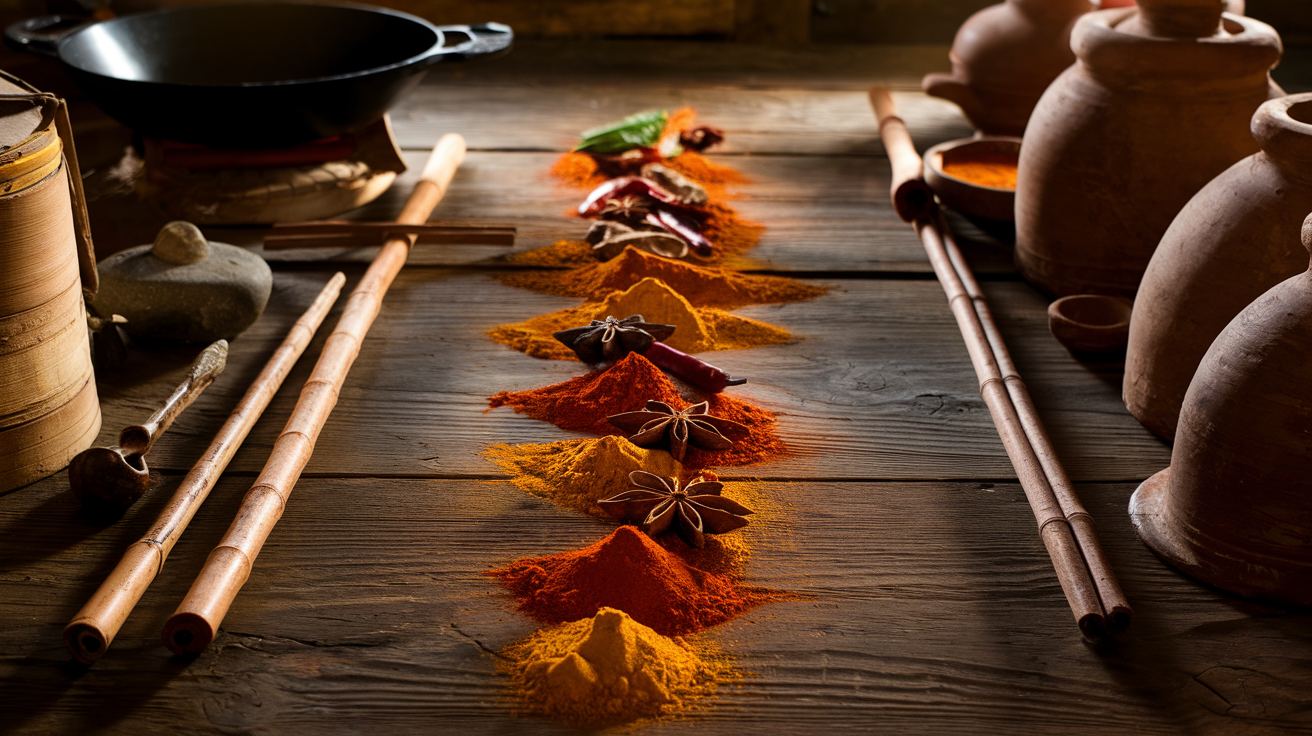
Star Anise: From Chinese Medicine to Native American Rituals
Ever noticed how some flavors seem to pop up everywhere? Star anise is one of those magical spices that somehow found its way into both Chinese and Native American traditions without any obvious connection.
In China, star anise has been a staple of traditional medicine for over 3,000 years. Chinese healers prized it for treating respiratory infections and digestive issues. The distinctive eight-pointed star contains powerful compounds like shikimic acid (yes, the same stuff used to make Tamiflu).
Meanwhile, across the ocean, several Native American tribes independently discovered star anise-like plants. The Kickapoo and Pawnee people used American star anise in healing ceremonies, burning it as incense during purification rituals. They believed its distinctive aroma created a pathway to the spirit world.
What’s wild is that these cultures developed such similar uses without contact. Both recognized the plant’s digestive benefits and respiratory healing properties. Both incorporated it into important ceremonies.
Cinnamon Bark: Ancient Trade Routes Between Continents
Think cinnamon is just for your morning latte? This spice has a more adventurous history than most people who use it.
Cinnamon bark traveled farther than most humans could dream of in ancient times. Originally from Sri Lanka, it made its way through Asia along the Silk Road, eventually reaching Native American trading networks through unexpected channels.
Archaeological digs at Pueblo sites in New Mexico have uncovered cinnamon remnants dating back to the 11th century – long before Columbus. How? Some researchers believe Pacific trade routes connected Asian merchants with coastal indigenous peoples.
Both cultures valued cinnamon for similar reasons:
- As a preservative for food storage
- For ceremonial burning in religious rituals
- As medicine for circulation problems
- To treat respiratory ailments
Exploring Parallel Discoveries of Similar Flavor Profiles
The human palate apparently has some universal preferences regardless of geography.
Indigenous peoples from vastly different regions somehow ended up with remarkably similar spice combinations. Take smoked paprika and chipotle – developed independently by Spanish and Aztec cultures, both discovered that smoking peppers creates a deep, complex flavor that transforms dishes.
Another example is the five-spice powder in Chinese cooking and the five-spice blends used by Navajo healers. Both contain warming spices like cinnamon, cloves, and anise variants. Both were considered balancing to the body’s energies.
This culinary convergence speaks to something deeper about human taste preferences and our relationship with plants. Across continents, people discovered similar flavor combinations that:
- Aid digestion
- Preserve foods
- Create memorable taste experiences
- Connect eating with spiritual practices
This isn’t just coincidence – it’s evidence of our shared human experience with the natural world.
Key Spices That Bridge Cultural Divides
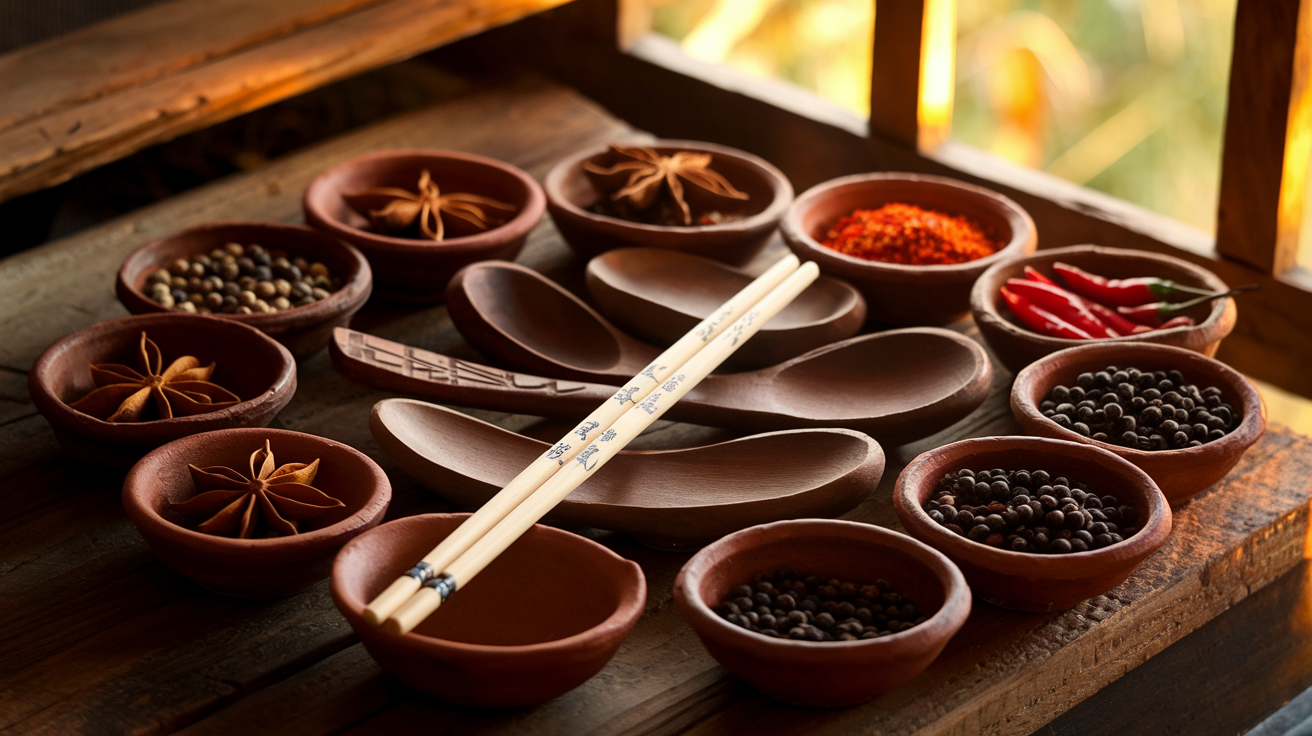
A. Szechuan Pepper and Its Native American Counterparts
Szechuan pepper creates that unmistakable tingly numbness Chinese food lovers crave. But did you know Native American cuisines feature similar sensations? The bark of the Northern Prickly Ash (also called “toothache tree”) delivers that same mouth-numbing quality. Apache and Cherokee healers used it medicinally, but clever cooks incorporated it into stews and meat dishes for its unique flavor profile.
The parallels don’t stop at the sensation. Both cultures valued these spices for their digestive benefits and warming properties. While Chinese cooks toast Szechuan peppercorns to release their citrusy aroma, Native Americans often crushed the bark or berries directly into dishes or made infusions.
B. Ginger’s Global Journey and Indigenous Alternatives
Ginger dominates Chinese cooking, but Native Americans weren’t without their zingy alternatives. Wild ginger (Asarum canadense) packs a similar punch with its earthy, spicy kick. The Iroquois and many woodland tribes harvested the rhizomes just as Chinese farmers collect ginger root.
While Chinese cooks might julienne ginger for stir-fries, Native American chefs would add wild ginger to hearty stews or pound it into medicinal teas. Both cultures recognized these rhizomes as stomach-settlers and cold remedies long before modern medicine confirmed their anti-inflammatory properties.
C. Five-Spice Powder: Finding Similar Blends in Indigenous Cooking
China’s five-spice powder balances the five flavors: sweet, sour, bitter, salty, and umami. Turns out, Native Americans created their own balanced spice blends too! Many tribes mixed juniper berries, sumac, wild onion, pine nuts, and sage to create complex flavor profiles.
These indigenous spice blends follow surprisingly similar principles to five-spice powder:
| Chinese Five-Spice | Native American Equivalent |
|---|---|
| Star anise | Juniper berries |
| Cloves | Wild mint/sage |
| Cinnamon | Sassafras |
| Fennel | Wild onion/garlic |
| Szechuan pepper | Sumac berries |
D. Chilies: The Pre-Columbian Exchange Connection
The most fascinating crossover? Chilies! Though the Columbian Exchange gets credit for introducing chilies to Asia, archaeological evidence suggests earlier contact. Chinese texts from the 1400s mention “foreign pepper” that sounds suspiciously like American chilies.
Native Americans had been cultivating countless chili varieties for thousands of years before Europeans arrived. From mild Anaheims to scorching tepins, they used chilies in everything from ceremonial drinks to preservative rubs.
Chinese cooks quickly adopted chilies into their repertoire when they arrived, creating iconic dishes like mapo tofu and kung pao chicken. Both cultures understood chilies’ preservative qualities and their ability to make humble ingredients extraordinary.
Traditional Cooking Techniques: Surprising Similarities
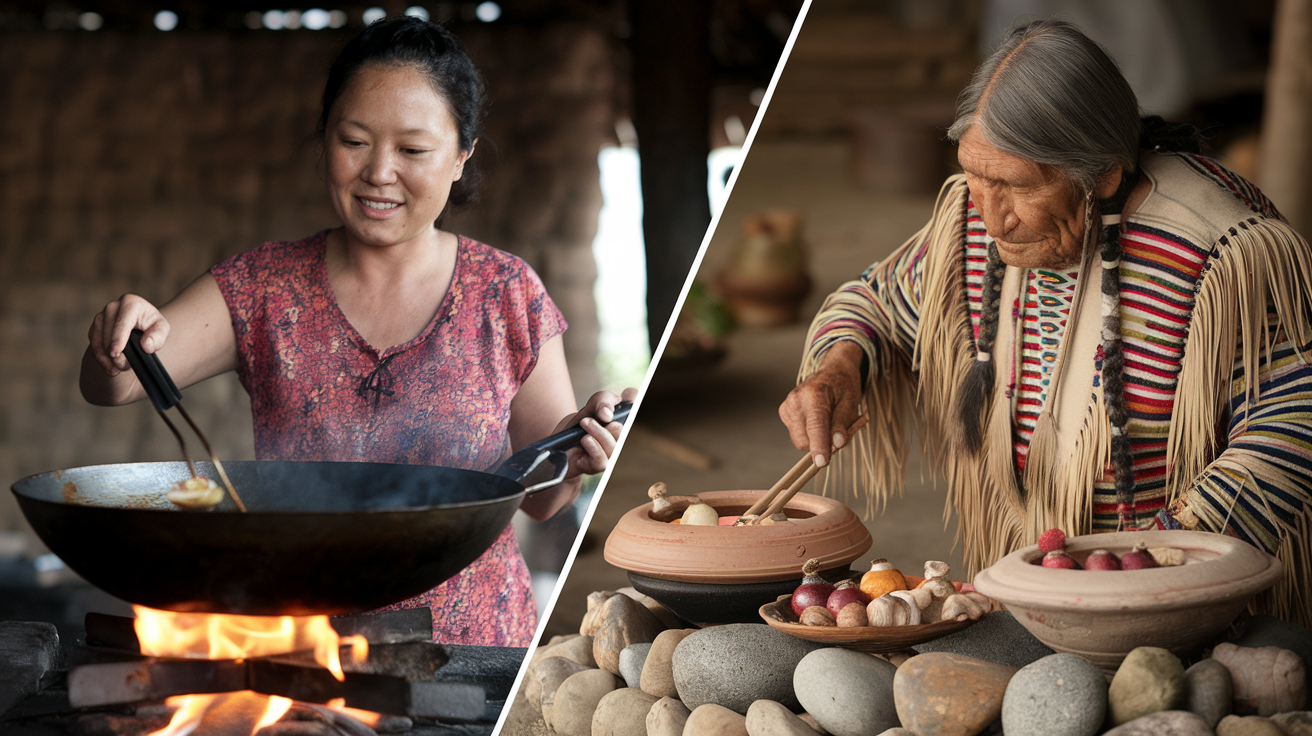
Smoking Methods and Preserved Flavors
Ever noticed how both Chinese and Native American cooks use smoke not just to cook food but to transform it? It’s no coincidence. Both cultures discovered that smoking meats and vegetables creates deep flavor profiles while preserving food for leaner times.
In traditional Chinese cooking, tea-smoking techniques infuse delicate proteins like duck and fish with aromatic complexity. They’d place tea leaves, star anise, and cinnamon on heated woks, creating smoke that carries spices directly into the food.
Meanwhile, across the ocean, Native American tribes like the Cherokee and Navajo developed smoking methods using cedar, hickory, and sage. They’d hang meat strips over low fires, letting smoke gently penetrate while incorporating native spices like wild juniper berries.
What’s fascinating? Both cultures recognized certain spices amplify during the smoking process. Peppercorns in Chinese smoking and chili peppers in Native American preparations intensify dramatically when combined with smoke.
Fermentation Practices Across Continents
The parallel development of fermentation between these cultures is mind-blowing. Chinese cooks have been fermenting soybeans into black bean paste for thousands of years, often adding star anise and Sichuan peppercorns to guide the fermentation’s flavor direction.
Native Americans? They mastered corn fermentation, creating nutritious staples like hominy. Many tribes added wild herbs and spices to their fermentation vessels that closely resemble those used in Asian traditions.
The similarities run deeper than technique. Both cultures understood that certain spices—garlic, ginger, and various peppers—serve dual purposes during fermentation: flavor enhancement and preservation.
Slow-Cooking Traditions and Their Spice Applications
Long before slow cookers existed, Chinese and Native American cooks perfected the art of patient cooking.
Chinese clay pot cooking—where meats, vegetables, and broths simmer for hours—relies heavily on balanced spice combinations. Five-spice powder (star anise, cloves, cinnamon, Sichuan peppercorns, and fennel seeds) forms the backbone of many slow-cooked dishes, with each spice releasing its essence at different heating stages.
Native American earth-oven cooking mirrors this perfectly. Foods wrapped in leaves with wild onions, juniper, and sage would slowly cook in underground pits. This method allows tough ingredients to tenderize while spices gradually infuse throughout.
Both traditions recognized that slow heat unlocks flavors impossible to achieve through quick cooking. They understood certain spices bloom beautifully under gentle heat—cinnamon and star anise in Chinese traditions, sumac and wild mint in Native American cooking.
Modern Fusion Possibilities: Honoring Ancient Connections
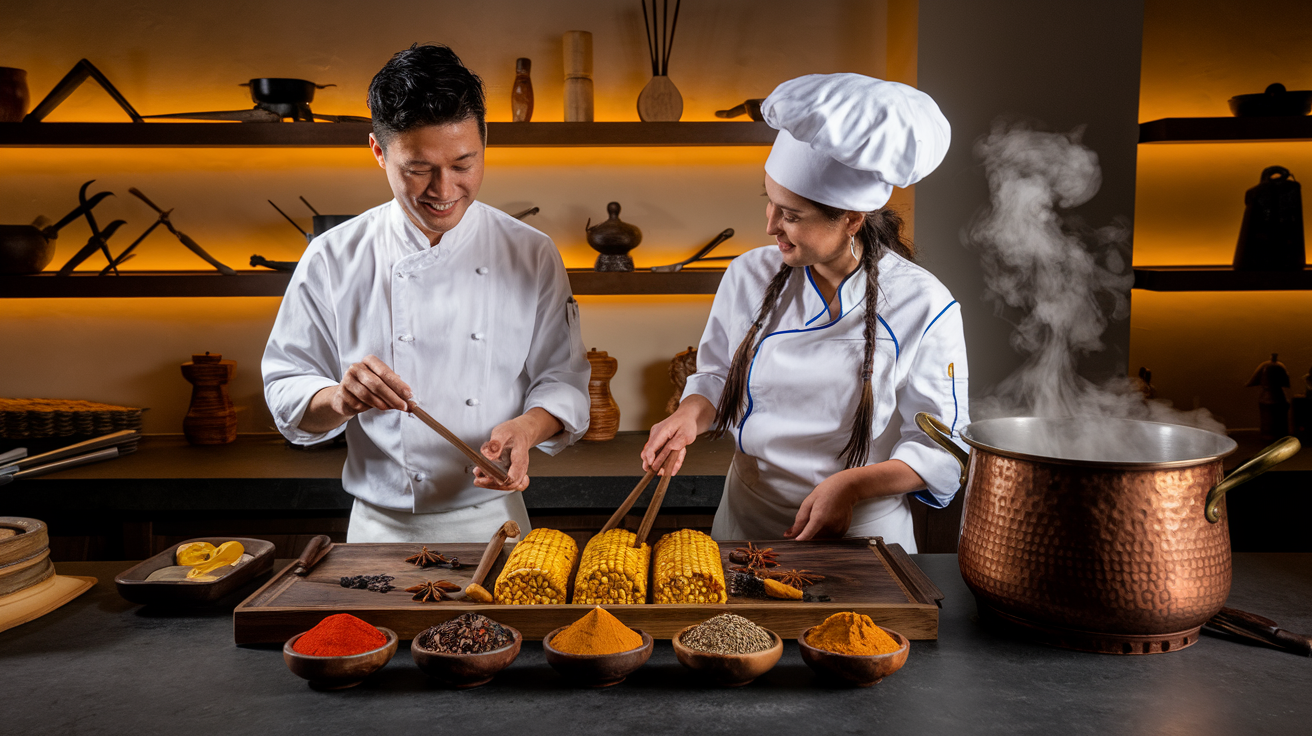
Modern Fusion Possibilities: Honoring Ancient Connections
A. Recipe Ideas Combining Both Culinary Traditions
The overlap between Chinese and Native American spice traditions creates a playground for culinary innovation. Try five-spice rubbed bison steaks with juniper berry sauce, or blue corn tortillas filled with Sichuan-spiced wild rice and foraged mushrooms. Star anise-infused berry compotes make wonderful toppings for acorn flour pancakes, while sage-scented dumplings filled with chestnuts and wild game offer a perfect fusion appetizer.
These combinations aren’t random mashups—they honor authentic flavor partnerships that make sense historically and gastronomically.
B. Balancing Authentic Flavors While Creating New Combinations
Creating respectful fusion isn’t about drowning dishes in sriracha or sprinkling “ethnic” ingredients as garnish. It’s about understanding the principles behind each culinary tradition.
When pairing Chinese five-spice with Native American ingredients like bison or corn, consider:
- Balancing warming spices with cooling herbs
- Respecting traditional cooking methods from both cultures
- Starting with complementary base ingredients first
- Highlighting shared spices rather than forcing contrasts
The goal isn’t novelty but harmony—dishes that could have existed if these ancient cultures had interacted more extensively.
C. Celebrating Cultural Heritage Through Shared Ingredients
When we cook with ingredients like wild ginger, juniper, and chiles that span both traditions, we’re not just making dinner—we’re telling a story of human connection.
Shared meals featuring these cross-cultural combinations create perfect opportunities for conversation about culinary history. A dinner featuring Navajo blue corn dumplings with Sichuan peppercorn becomes more than food—it’s a delicious history lesson.
Food connects us to ancestry in ways words sometimes can’t. These dishes honor the wisdom of those who discovered these powerful flavors thousands of years ago.
D. Sustainable Spice Sourcing Inspired by Ancient Practices
Both Chinese and Native American traditions emphasized sustainability long before it became trendy. Their harvesting practices offer valuable lessons:
- Wild-harvest only what’s abundant
- Cultivate native species in home gardens
- Support small-scale spice farmers using traditional methods
- Learn proper harvest timing to ensure plant regeneration
- Trade directly with indigenous producers when possible
These approaches not only preserve cultural knowledge but ensure these precious flavors remain available for future generations.
E. Health Benefits of These Cross-Cultural Spice Combinations
The medicinal properties recognized by both traditions often complement each other beautifully. Chinese star anise pairs with Native American elderberry for powerful immune support. The anti-inflammatory properties of turmeric enhance the digestive benefits of wild mint.
Modern research confirms what traditional healers knew: these spices aren’t just flavorful—they’re medicine. Regular consumption of diverse spices reduces chronic inflammation, improves digestion, and supports overall wellness.
The most exciting part? These combinations often work synergistically, with compounds in one spice enhancing the bioavailability or effectiveness of another.
The Anthropological Significance of Shared Spice Usage
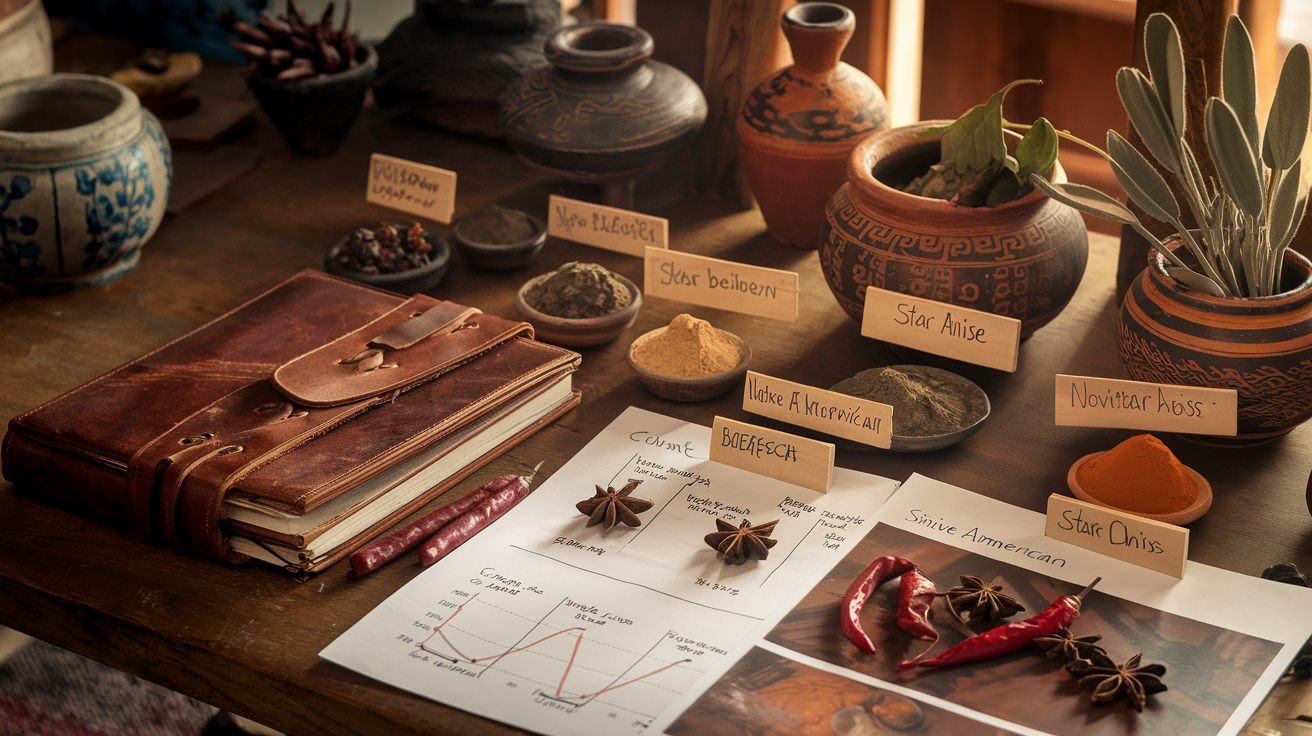
A. What Common Spices Reveal About Human Migration
The spice cabinets of Chinese and Native American kitchens tell a fascinating story that goes beyond flavor. When you look at shared spices like wild ginger, cinnamon, and various peppers, you’re witnessing ancient human migration patterns etched into culinary traditions.
Take Sichuan peppercorn and its Native American counterparts. Both cultures independently discovered plants that create that distinctive numbing sensation. This parallel development speaks volumes about human ingenuity across continents.
Archaeological findings show that spice trade routes between Asia and the Americas existed long before Columbus. Maritime evidence suggests Pacific crossings as early as 5000 BCE, with spice remnants found in pottery from both regions showing striking chemical similarities.
These shared spices aren’t coincidental. They’re smoking guns pointing to prehistoric contact that history books rarely mention. The Bering Strait theory explains some similarities, but doesn’t account for the specific cultivation knowledge that seems to have traveled between these distant cultures.
B. How Geography Influences Spice Discovery and Application
Mountains shape spice traditions in fascinating ways. Both the Andes and Himalayas fostered similar aromatic herbs despite their separation by oceans. Why? Similar elevations create comparable growing conditions.
Coastal communities in both China and Pacific Northwest Native territories developed remarkably similar preservation techniques using similar salt-tolerant herbs. The relationship looks something like this:
| Geographic Feature | Chinese Spice Response | Native American Parallel |
|---|---|---|
| Humid lowlands | Developed drying techniques with star anise | Used sassafras with similar properties |
| Arid regions | Preserved with dried chili peppers | Utilized similar capsaicin-rich plants |
| River valleys | Cultivated ginger variants | Grew wild ginger relatives |
Weather patterns pushed both cultures toward similar solutions. During harsh winters, both developed warming spices that increase circulation. During wet seasons, both discovered antifungal spices that prevent food spoilage.
C. Cultural Ceremonies Centered Around Similar Spices
The ceremonial use of spices reveals the deepest connections between these cultures. Both Chinese and Native American spiritual practices feature sacred smoke from similar aromatic plants.
Healing ceremonies in both traditions rely on nearly identical applications of ginger, cinnamon, and various peppers. Chinese traditional medicine and Native American healing practices both recognize these spices’ warming properties for treating similar ailments.
Coming-of-age rituals often incorporate bitter spices as symbols of life’s challenges. The symbolic language surrounding these spices echoes across both cultures – purification, protection, transformation.
What’s truly striking is how both cultures associate specific spices with celestial events. Star anise in Chinese tradition and anise seed among southwestern Native tribes both connect to celestial navigation and winter solstice celebrations. This cosmic connection suggests these spices carried profound cultural significance beyond their flavors.
Marriage ceremonies in both cultures feature similar spice-infused teas, symbolizing the bitter and sweet aspects of partnership. The parallels are too specific to be coincidental.
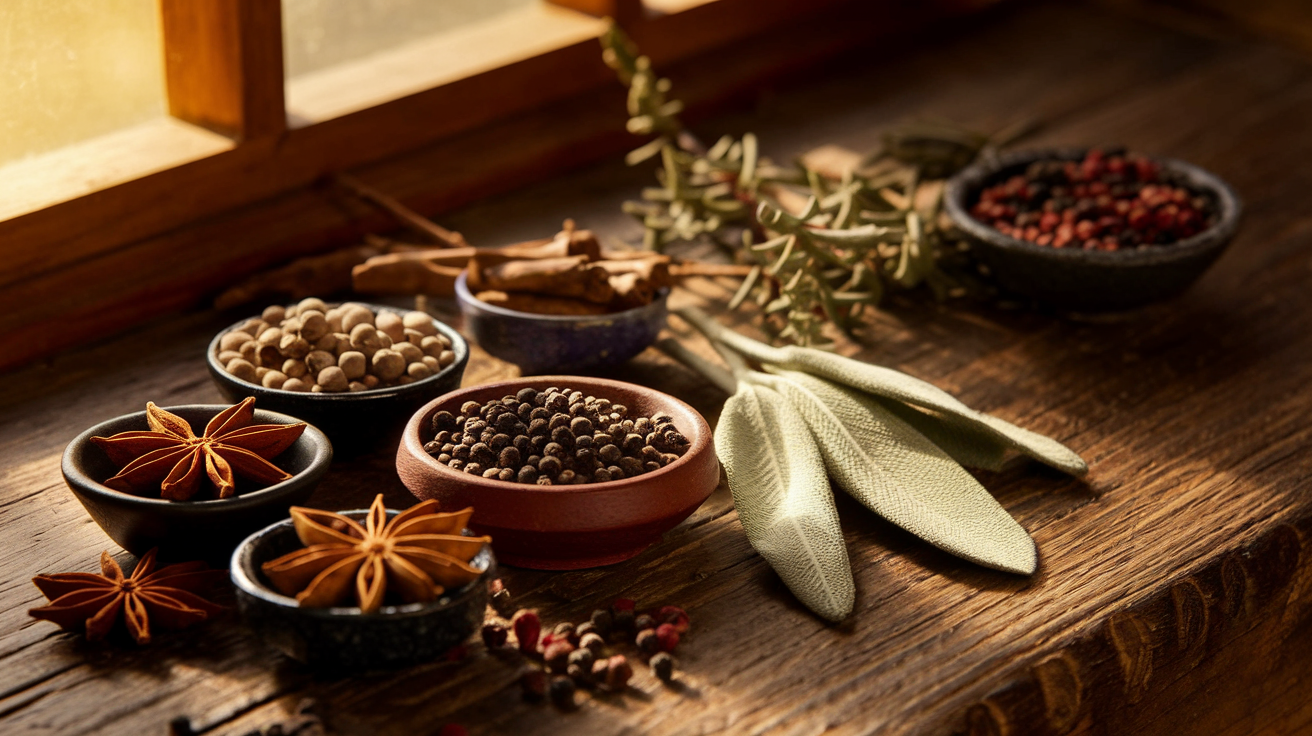
The remarkable connections between Chinese and Native American culinary traditions reveal how ancient spices have transcended geographical boundaries and united seemingly disparate cultures. From the warming properties of cinnamon and star anise to the medicinal applications of ginger and sage, these shared ingredients demonstrate that human innovation in food preparation follows similar paths despite vast distances. The parallel development of smoking, steaming, and fermentation techniques further highlights our shared human experience with food.
As we explore these culinary bridges, we gain not just new fusion recipe possibilities but deeper anthropological insights into human migration, trade routes, and the universal language of flavor. By honoring these ancient connections in our modern kitchens, we participate in a continuing dialogue between cultures that has been simmering for centuries. The next time you reach for a familiar spice, consider its journey across continents and its role in bringing together diverse culinary traditions in ways we’re only beginning to fully appreciate.






https://shorturl.fm/VeYJe
Start earning passive income—become our affiliate partner! https://shorturl.fm/KYM47
Start profiting from your network—sign up today! https://shorturl.fm/Di0VC
Start sharing, start earning—become our affiliate today! https://shorturl.fm/xq1cV
https://shorturl.fm/2QnSy
https://shorturl.fm/ADN2M
https://shorturl.fm/R8tqy